I get questions all the time about nontoxic nail polish. People usually refer to the words, non-toxic nail polish but I prefer natural nail polish. I don’t think nail polish is horrible and I use it myself but I also think even natural nail polish isn’t perfect. I love the look of freshly polished nails. I don’t live in a bubble, nor do I claim too. I want to live as healthy of a lifestyle as possible for sure! But I also want to enjoy my life and not constantly be “afraid” of chemicals. It really comes down to making an informed decision for yourself. I used to really avoid anything and everything when I first went green- nothing was safe! Then I slowly came out of my shell and realized I can’t live that way forever. It’s about balance! They say stress is linked to so many health issues- I agree. Sometimes just relaxing and enjoying life is better medicine for us than avoiding everything.
That being said, I do realize that some people are highly sensitive to nail polish still or just want to avoid using it. I respect that as well. My goal as a blogger is to give you the information you need to make an informed decision for you and your family. What works for me, might not always work for you.
Ok, now that we have that out of the way let’s talk nontoxic nail polish. When I say nontoxic nail polish here’s what I’m talking about…
Ingredients I Avoid in Nail Polish:
- Parabens
- Sulfates
- Formaldehyde
- Formaldehyde Resin
- Camphor
- Dibutyl Phthalate
- Toluene
- Triphenyl Phosphate
- Xylene
- Bismuth Oxychloride
- Ethyl Tosylamide
My favorite brand of nontoxic nail polish that I’ve found is Aila. I love how rich their colors are and the variety! Plus, they perform like my conventional nail polishes.
Aila filled me in on a few things happening in marketing nail polishes to the natural market too. A lot of companies will start saying 10-free or 11-free- not that it’s bad but many ingredients they include in their polishes have not been used in nail polishes for years. It’s a marketing tactic used by many companies to appeal to a natural demographic.
Water based polishes are often touted as being the best option. However, after trying several brands, they still weren’t giving me the same nail look I used to have with conventional polishes. I mean who wants their nail polish chipping in a few hours? What’s the point?! I’ve tried a lot of “natural” nail polishes and I really have come to love Aila the best. The formula is so smooth, it doesn’t get gunky, they’re as clean as they come while still being effective and they’re color range is so chic! I don’t feel I have to sacrifice at all!
I especially love their Better than Gel top coat. It rates a 1 on EWG and locks in your nail color so well you would think you’re wearing a gel polish but you’re not! You have to try it! My other favorites from their nail polish line are:
Room 212- a rich plum color, perfect for fall and winter.
Bodega- the red that looks good on everyone.
Namaste- a pretty neutral grey tone.
California Love- A California coral sunset on your hands and feet.
Wheez- A bubble gum pink.
I wanted to dive a little deeper into natural nails to really answer all of your questions. So I did an interview with the founder of Aila Beauty, Cary Gannon, to answer some of your most asked questions about natural nails! I thought what better person to answer these questions than someone who owns a natural nail company. I so loved hearing her thoughtful responses and sharing her knowledge with us about natural nail care.
*Interview with Aila Beauty Founder- Cary Gannon:
QUESTIONS-
1. Is there such a thing as non-toxic nail polish?
Yes and no. I love this question because truth be told ANYTHING (natural or man made) has the potential to be toxic. Natural chemicals can be more dangerous than man-made chemicals. Mother Nature is our best chemist and She can kill you in a heart beat.
Essential oils are ‘natural’ but contain anywhere from 80-300 chemicals per oil and can be toxic when used improperly. Water is another natural chemical that can be deadly if used improperly. Examples of this are the frat boys I see in the ER every year who have been dared to drink a gallon of water in an hour and they die of cardiac arrest FROM WATER.
It seems the green beauty industry is hell-bent on defining toxicity in the binary matrix of toxic vs. non-toxic when there is soooooo much more to it than this from a scientific and medical perspective. There are some bloggers and self-proclaimed ‘green beauty experts’ who read a few obscure articles and proclaim the toxicity of a beauty product when the reality is that toxicity is so much more than one specific natural or man-made chemical.
In my view toxicity should be viewed through 4 different lenses…and thus begins your dissertation…
1) The first question we need to ask is ‘Is the product toxic to the SPECIFIC BODY PART it is being applied to’?
If we are using nail polish as the example then the question is ‘does the nail polish damage the nail specifically?’ We want a nail product that does not strip the nail of all the natural oils or increase rate of fracture of the nail. We want a product that does not increase the bacterial or fungal bio-burden and make our nails more susceptible to fungus. We want a product that is easily removed and does not weaken the nails.
Nails are very different than skin. Skin absorbs way more than nails. Nails have pores and will expand and contract just like skin but they do not absorb chemicals the same way as skin does (similar to hair). You can apply certain chemicals to nails that do not damage the nails and do not systemically absorb into the body. These same chemicals could not be applied to skin because the skin is a different organ all together. Does this make sense? Another example we could use are essential oils. Some oils are safe for the skin but others are toxic to the skin. They are organ specific.
2) The 2nd question we need to ask ourselves about a beauty product is ‘Is the product systemically absorbed and potentially damaging the the ORGANISM AS A WHOLE?’. Meaning, does the chemical absorb through the nail or the skin and enter the blood stream and potentially create damage to the entire body. Here is where nail polish, skin products, beauty products etc. become scary.
An example of this are parabens used as a preservative in beauty products. We believe that these are systemically absorbed through the skin and we know there is an increase in paraben levels in breast cancer tumors. We are fortunate that most molecules are not able to penetrate the nail plate and be systemically absorbed thus making chemicals that could be systemically toxic irrelevant when applied to the nail.
3) The third question about toxicity is PERSON specific. Meaning there are chemicals that are ‘non-toxic’ that 99% of people can use and be fine but there are always certain people who will be allergic or intolerant to a chemical.
Peanut butter is technically ‘non-toxic’ in every way BUT if you are allergic to peanuts it will kill you very quickly. This is the same for some beauty products. Certain chemicals are considered totally safe and completely non-toxic but if a specific person has an intolerance to it then the product is toxic to the INDIVIDUAL. I use essential oils as an example here again. Most people can use essential oils without issue BUT some people are highly allergic to some essential oils thus the oil is TOXIC to the INDIVIDUAL.
4) Lastly, can we use the ‘toxic’ component of the chemical to our advantage? Believe it or not we do this ALL the TIME. Even in beauty products.
One of the first examples of using toxicity to our advantage is lip plumping products. Some of these products contain natural chemicals (usually essential oils) to create the ‘bee sting’ appearance of the lips to enlarge the lips and make them look fuller and redder. The chemicals in these products are technically non-toxic but when applied to the mucous membrane of the lip create a toxic reaction that we use to our benefit.
Another example is Botox. Botox is a 100% NATURALLY occurring chemical that is produced by the Clostridium botulinum bacteria. It can be found in honey. If we encounter this chemical in nature it causes death by paralysis but we have found a way to use this ‘toxic’ natural chemical to our advantage in medicine. The obvious use is in relaxing wrinkles but we also use this to treat migraines, contracted muscularture in Cerebral Palsy, hyperhidrosis etc. Botox is technically toxic but if we use it properly can be non-toxic.
This is how I view all chemicals. My belief is that it is a mistake to put every chemical in a toxic vs. non-toxic matrix because there is so much more than that.
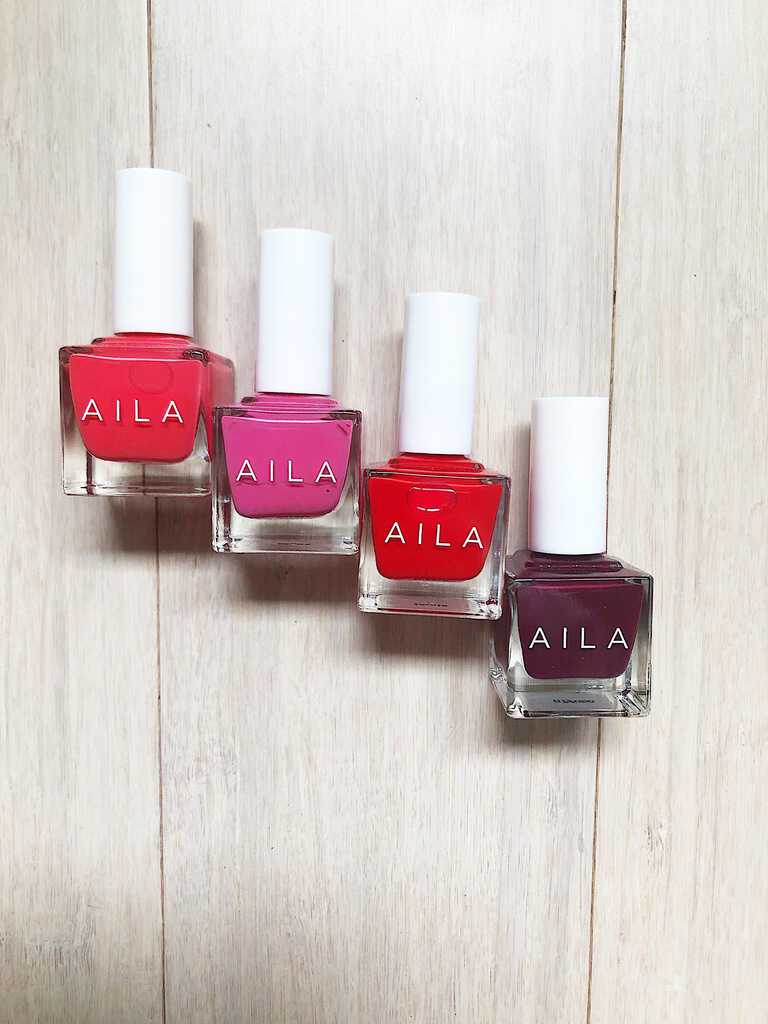
Love all the nontoxic nail polish colors from Aila!
2. What are the most toxic ingredients people should avoid in nail polish?
I guess to me the toxic ingredients that people should avoid in nail polish would be chemicals that are toxic to nails or absorbed through the nail and toxic to the body.
Other than the chemicals listed on our website I consider acrylic nails and gel nails to be highly toxic to the nails specifically. These chemicals literally remove layers of the nails each and every time they are removed and terribly weaken the nails. It takes 6-9 months for fingernails to regenerate and 9-12 months for toenails to regenerate so you cannot attain healthy nails for this amount of time after wearing acrylic or gel.
Systemically I would say avoid all polishes with TPHP in them. TPHP is an endocrine disruptor and has been proven to absorb through the nail bed and enter your blood stream.
3. I’ve often heard that water based nail polish is better than solvent- is this true?
No. I’m sure that people who firmly believe water based polishes would disagree but my answer is a firm no. Water does several things that are unhealthy for our nails and our bodies.
First and foremost water harbors bacteria, yeast, fungus, mold and disease. Water is the perfect environment for bacteria etc. to proliferate and reproduce. Water based polishes will grow bacteria, yeast, mold etc. UNLESS they are mixed with a ton of preservatives to prevent bacterial growth. If the preservatives are not accurately measured then the polish will start to grow bacteria in the bottle. AILA’s formula is 100% bacteria free and will not grow bacteria.
We are COVERED in bacteria, yeast, fungus mold etc. and every time we touch our finger nails or toe nails with the polish brush and then replace the brush in the bottle we are adding bacteria to the bottle of polish. If there is not the correct amount of preservatives in the polish to kill the bacteria then the water based polish potentially spreads disease and the bottle of polish essentially becomes a large petrie dish. Bacteria from one person will grow in the bottle and then the next person using the polish is exposed to the bacteria.
Second, some water based polishes say they are healthy but at closer look their other ingredients reveal that they contain ACRYLIC. The polishes are water based and function well but acrylic is very damaging to the nail.
Third, water softens and weakens the nails increasing their rate of fracture. Overexposure to water is not healthy for skin OR nails. AILA advocates a dry manicure system for this very reason. We don’t want to do anything that weakens the nail. Dry manicures are not new technology and it is well established that applying water to the nails weakens them.
4. Having worked on nails for a time as a cosmetologist, my concern was the smell too. Does the smell of nail polish warrant concern or is it just being aware of proper ventilation?
It depends on the product. The smell from AILA’s formula is butyl acetate which is an organic compound found in fruits. It isn’t toxic unless the person is sensitive to it. There are some chemicals in certain nail products that should not be inhaled long term. Most of these chemicals are associated with acrylic nail salons. Ventilation can be helpful but is not fully protective.
5. Should you avoid wearing nail polish when pregnant or nursing? (I get this question a lot from readers)
As a rule, I always refer these ladies back to their doctors. We should never offer our approval for any products for pregnant or nursing mothers because the legal liability is far too high. You definitely do not want to be the person who told a pregnant mother that they can use any product because if anything is wrong with their baby you will have liability. The truth is that every woman wants to have a perfect baby but not every woman gets to have a perfect baby. Most of the time this is through no fault of their own. It’s best to stay clear of this question.
6. Should people be as concerned with nail polish removers as polishes?
Yes. Humans actually produce our own acetone and it is typically present in blood and in urine. Diabetics, pregnant women, nursing mothers and children have higher levels of acetone so in proper amounts it is not toxic to humans systemically. It does however desiccate the nails and remove the nails’ natural oils. When nails don’t have enough oil they break and fracture more easily. I prefer AILA’s 3-in-1 natural soy nail polish remover with vitamins A,C & E and Argan Oil to nourish and strengthen the nails.
7. What are some tips or advice when wanting a manicure at a nail salon but don’t have the option of a natural nail salon. Are there ways to avoid toxins?
Skip the soaking and go straight for a dry manicure/pedicure. Soaking the nails in water expands the pores of the nail and the skin. All the chemicals they use to ‘sterilize’ the water are immediately absorbed into the blood stream and enter your body. The soaking expands the nail plate and weakens the nails increasing the rate of fracture and breakage of the nail plate. Lastly the soaking expands the nails. The nails eventually contract back down to their normal size but the contracting causes micro-fractures in the manicure and the manicure or pedicure will chip sooner and won’t last as long.
I also recommend taking your own base coat, polish and top coats. Some salons will ‘water-down’ their polishes and when they do that they grow bacteria.
8. What makes Aila different than other nail polish companies?
Our team and our commitment to constantly improve our products. We can have the best product in the world but if our team isn’t committed to each other and to our customers then we will never succeed. Plus our names are hilarious and all of them have some sort of embarrassing story behind them LOL!!!
Did you get your questions answered? Have any others? Check all of Aila’s colors on Amazon here! Leave me a comment below on what your favorite nontoxic nail polish is!
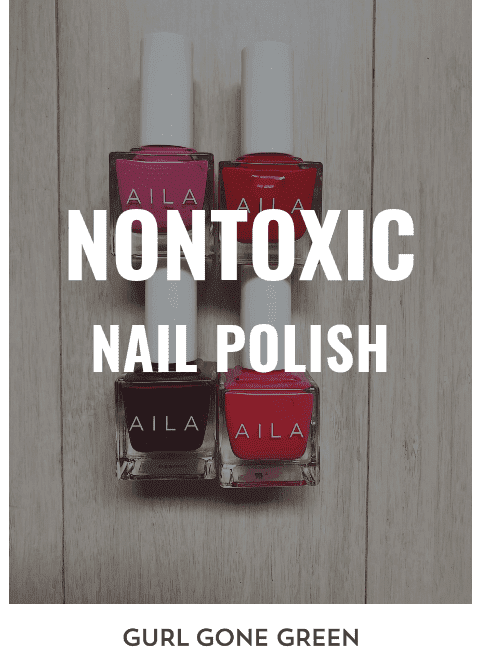
Sharing my full review on my favorite natural nail polish.

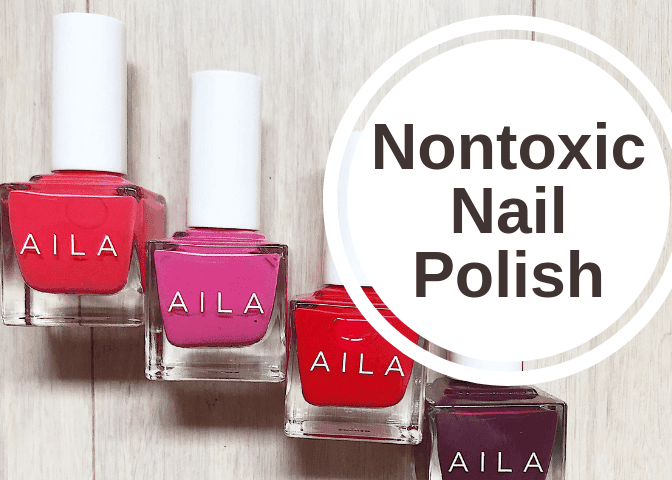
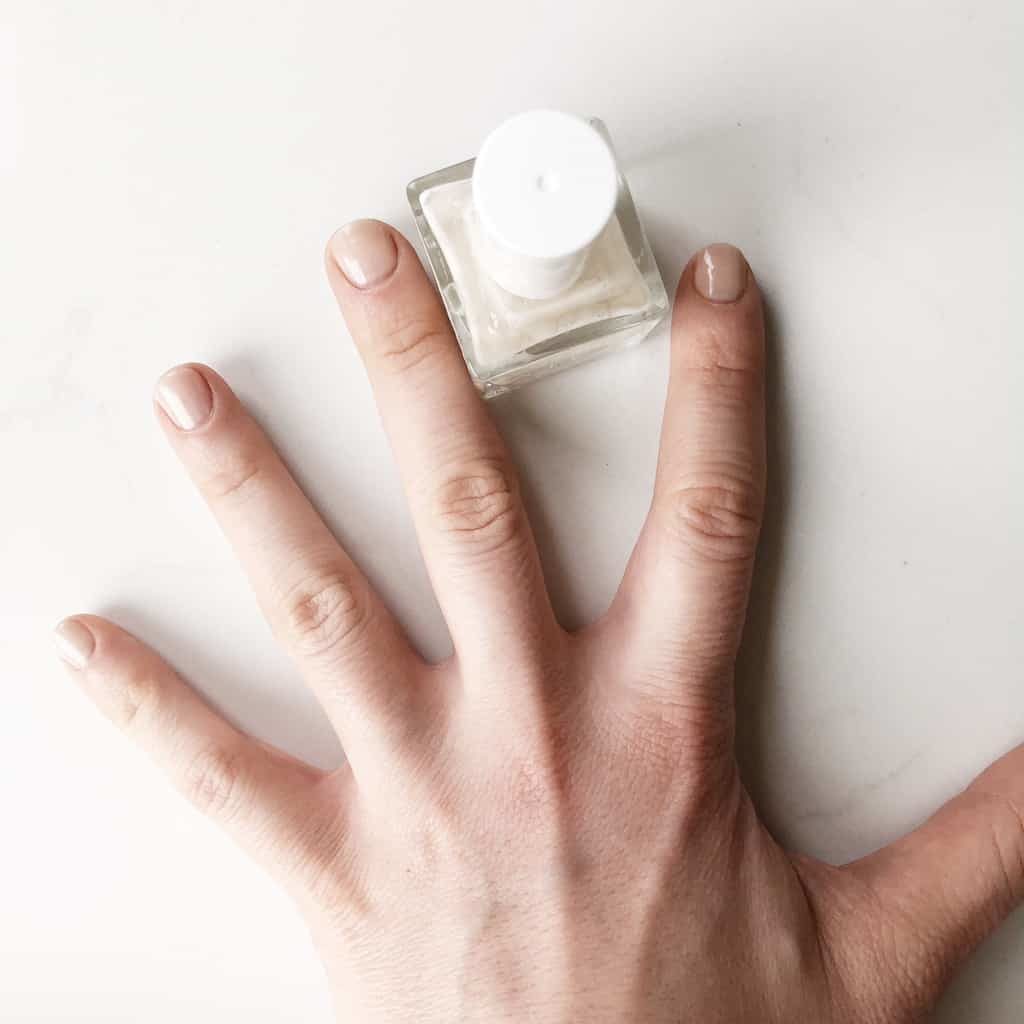
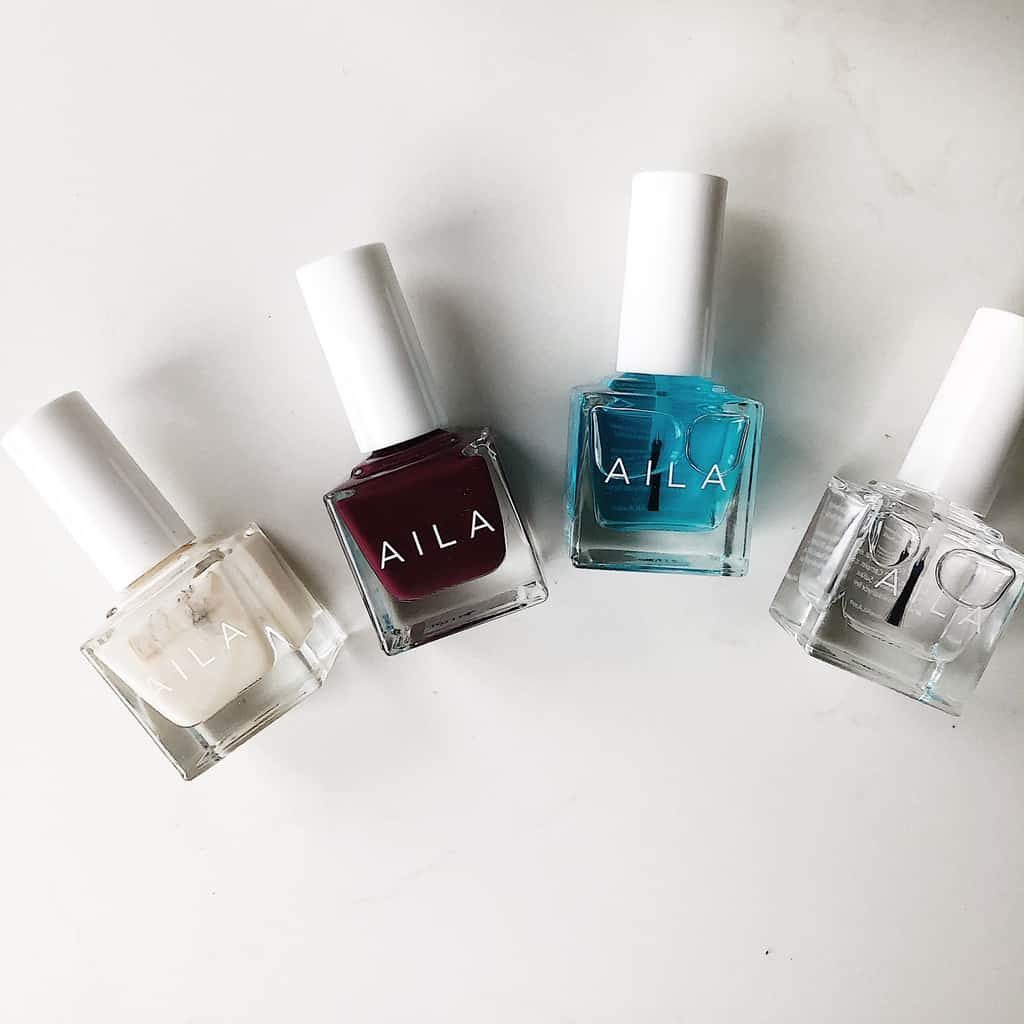
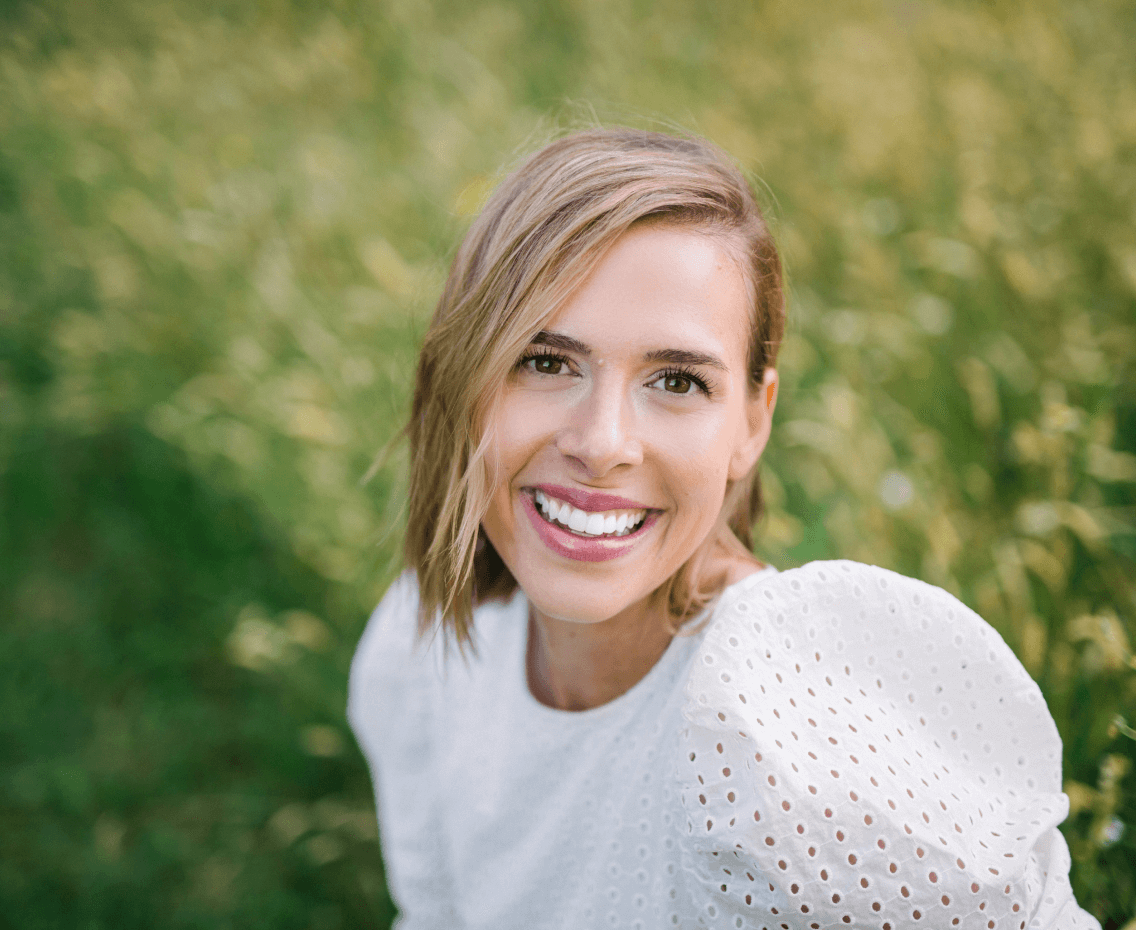

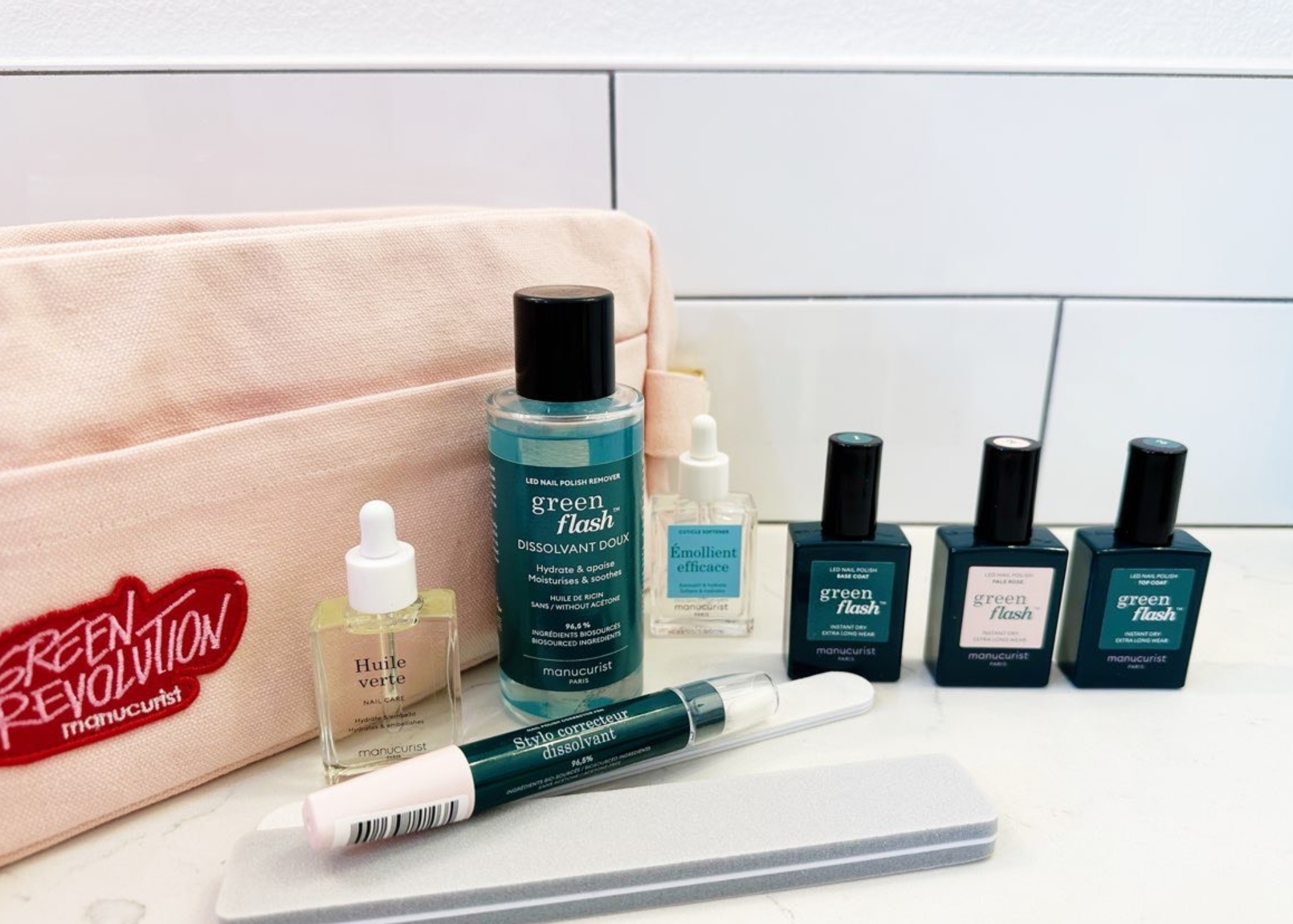
hi – i am curious what you think of Zoya nail polish and if it one you would recommend?
Hi Melanie! I think it’s a great option! They remove a lot of the nasties in conventional polish.
Hi Saba! So interesting! Thanks for sharing. I will keep my eye out for a natural polish with those certifications.
Hi Saba! Thanks for the info- so interesting! I will definitely keep my eyes open for one.
I seriously learned so much from this! Thanks so much! I love your content. What are your thoughts on using EO’s in general? Do you use them?